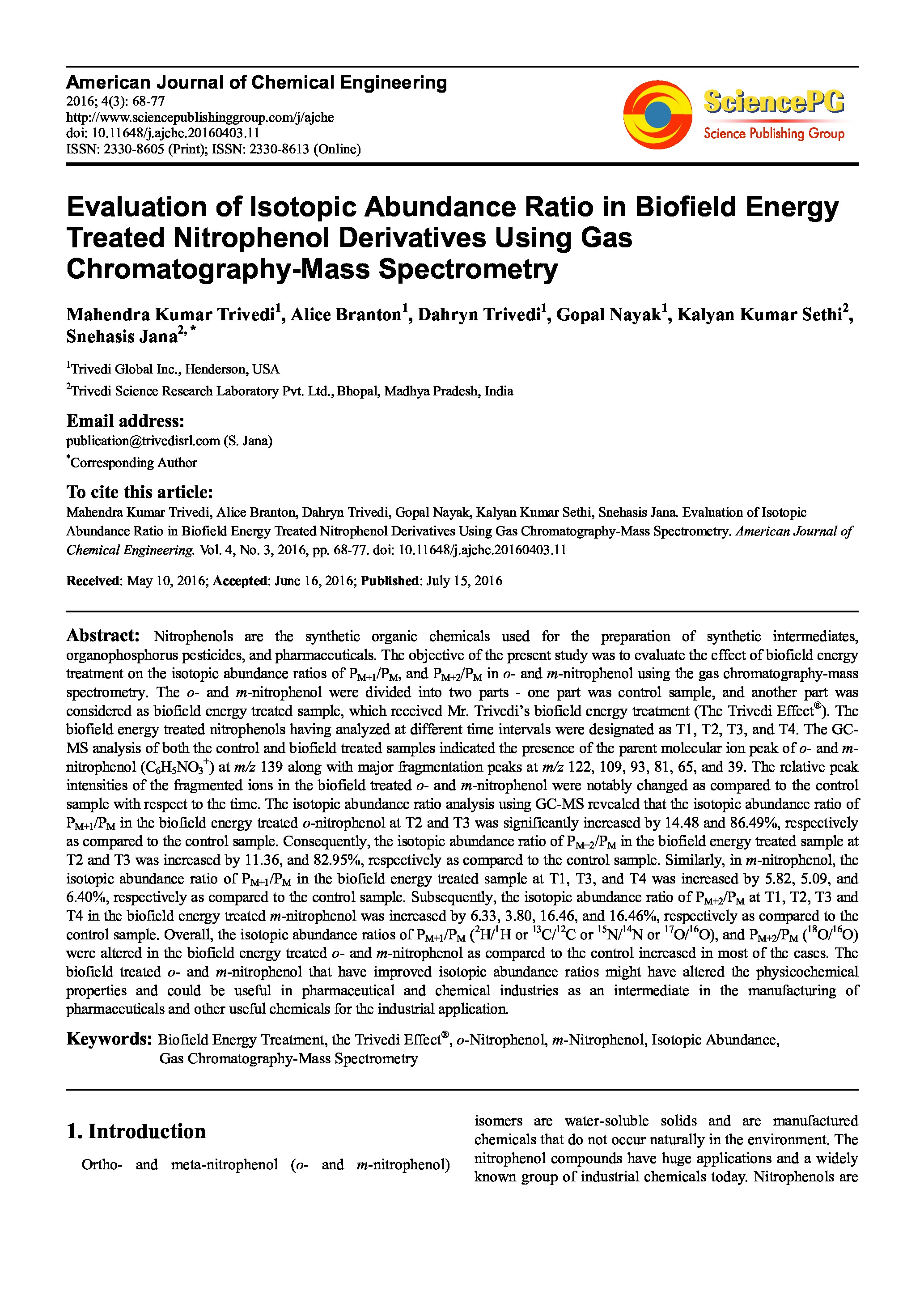Evaluation of Isotopic Abundance Ratio in Biofield Energy Treated Nitrophenol Derivatives Using Gas Chromatography-Mass Spectrometry
Affiliation
Trivedi Global Inc.; Trivedi Science Research Laboratory Pvt. Ltd.
Main category
Natural Sciences (Analytical Chemistry, Method Development (Chemistr)
Abstract
Nitrophenols are the synthetic organic chemicals used for the preparation of synthetic intermediates, organophosphorus pesticides, and pharmaceuticals. The objective of the present study was to evaluate the effect of biofield energy treatment on the isotopic abundance ratios of PM+1/PM, and PM+2/PM in o- and m-nitrophenol using the gas chromatography-mass spectrometry. The o- and m-nitrophenol were divided into two parts - one part was control sample, and another part was considered as biofield energy treated sample, which received Mr. Trivedi’s biofield energy treatment (The Trivedi Effect®). The biofield energy treated nitrophenols having analyzed at different time intervals were designated as T1, T2, T3, and T4. The GC-MS analysis of both the control and biofield treated samples indicated the presence of the parent molecular ion peak of o- and m-nitrophenol (C6H5NO3+) at m/z 139 along with major fragmentation peaks at m/z 122, 109, 93, 81, 65, and 39. The relative peak intensities of the fragmented ions in the biofield treated o- and m-nitrophenol were notably changed as compared to the control sample with respect to the time. The isotopic abundance ratio analysis using GC-MS revealed that the isotopic abundance ratio of PM+1/PM in the biofield energy treated o-nitrophenol at T2 and T3 was significantly increased by 14.48 and 86.49%, respectively as compared to the control sample. Consequently, the isotopic abundance ratio of PM+2/PM in the biofield energy treated sample at T2 and T3 was increased by 11.36, and 82.95%, respectively as compared to the control sample. Similarly, in m-nitrophenol, the isotopic abundance ratio of PM+1/PM in the biofield energy treated sample at T1, T3, and T4 was increased by 5.82, 5.09, and 6.40%, respectively as compared to the control sample. Subsequently, the isotopic abundance ratio of PM+2/PM at T1, T2, T3 and T4 in the biofield energy treated m-nitrophenol was increased by 6.33, 3.80, 16.46, and 16.46%, respectively as compared to the control sample. Overall, the isotopic abundance ratios of PM+1/PM (2H/1H or 13C/12C or 15N/14N or 17O/16O), and PM+2/PM (18O/16O) were altered in the biofield energy treated o- and m-nitrophenol as compared to the control increased in most of the cases. The biofield treated o- and m-nitrophenol that have improved isotopic abundance ratios might have altered the physicochemical properties and could be useful in pharmaceutical and chemical industries as an intermediate in the manufacturing of pharmaceuticals and other useful chemicals for the industrial application.
DOI
10.18147/smn.2017/paper:495
Do you have problems viewing the pdf-file? Download paper
here
If the paper contains inappropriate content, please
report the paper. You will be redirected to the landing page.
